Greek vs Mongolian Community Comparison
COMPARE
Greek
Mongolian
Social Comparison
Social Comparison
Greeks
Mongolians
9,193
SOCIAL INDEX
89.4/ 100
SOCIAL RATING
29th/ 347
SOCIAL RANK
8,008
SOCIAL INDEX
77.6/ 100
SOCIAL RATING
93rd/ 347
SOCIAL RANK
Mongolian Integration in Greek Communities
The statistical analysis conducted on geographies consisting of 138,164,910 people shows a moderate positive correlation between the proportion of Mongolians within Greek communities in the United States with a correlation coefficient (R) of 0.407. On average, for every 1% (one percent) increase in Greeks within a typical geography, there is an increase of 0.046% in Mongolians. To illustrate, in a geography comprising of 100,000 individuals, a rise of 1,000 Greeks corresponds to an increase of 46.0 Mongolians.
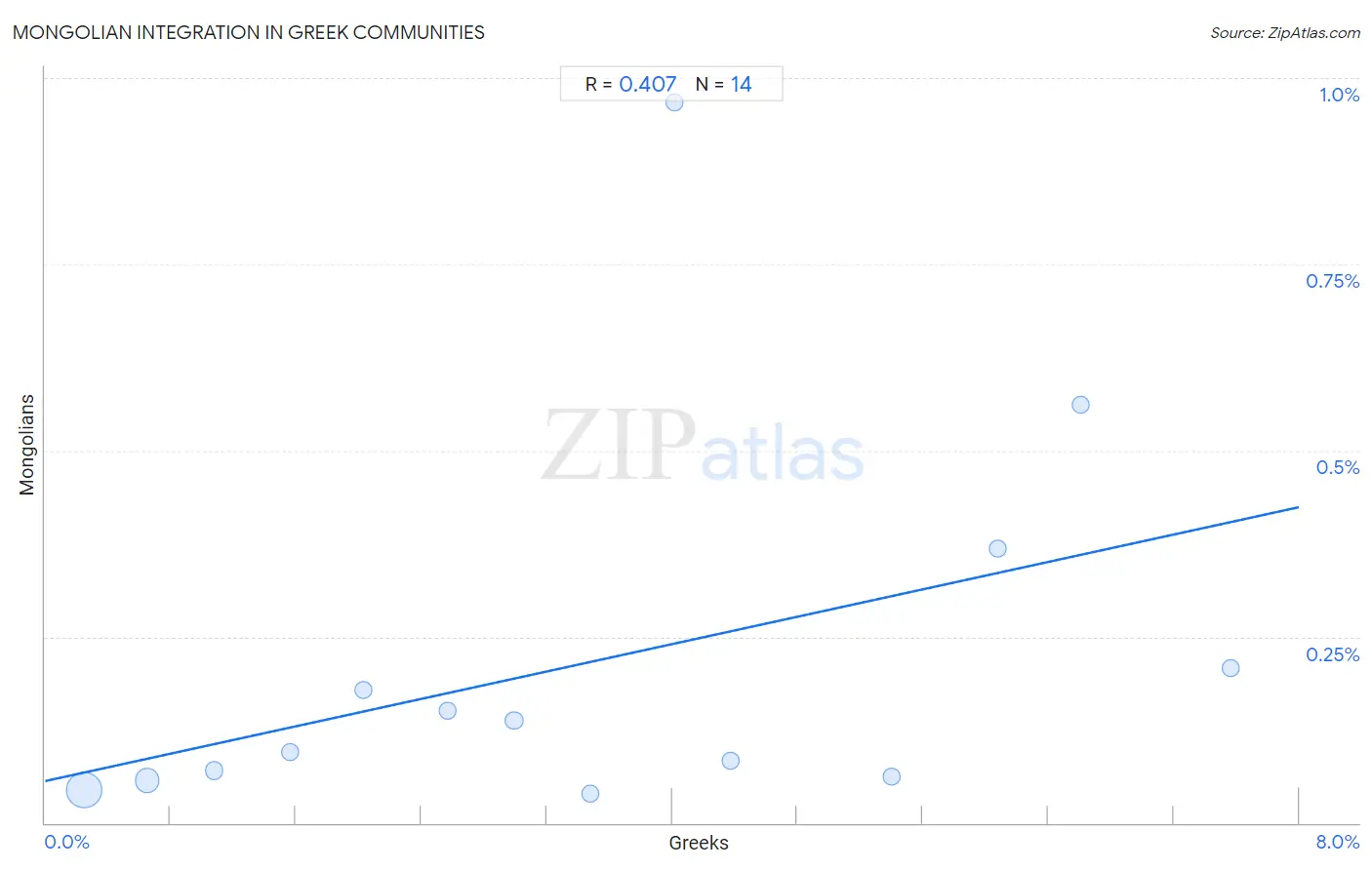
Greek vs Mongolian Income
When considering income, the most significant differences between Greek and Mongolian communities in the United States are seen in wage/income gap (28.2% compared to 26.6%, a difference of 6.1%), householder income under 25 years ($53,715 compared to $52,540, a difference of 2.2%), and householder income ages 25 - 44 years ($106,457 compared to $104,578, a difference of 1.8%). Conversely, both communities are more comparable in terms of householder income over 65 years ($65,306 compared to $65,326, a difference of 0.030%), median earnings ($51,164 compared to $51,038, a difference of 0.25%), and per capita income ($49,309 compared to $49,173, a difference of 0.28%).

| Income Metric | Greek | Mongolian |
| Per Capita Income | Exceptional $49,309 | Exceptional $49,173 |
| Median Family Income | Exceptional $115,192 | Exceptional $114,553 |
| Median Household Income | Exceptional $94,735 | Exceptional $93,971 |
| Median Earnings | Exceptional $51,164 | Exceptional $51,038 |
| Median Male Earnings | Exceptional $61,242 | Exceptional $60,350 |
| Median Female Earnings | Exceptional $42,336 | Exceptional $42,542 |
| Householder Age | Under 25 years | Exceptional $53,715 | Good $52,540 |
| Householder Age | 25 - 44 years | Exceptional $106,457 | Exceptional $104,578 |
| Householder Age | 45 - 64 years | Exceptional $112,630 | Exceptional $111,602 |
| Householder Age | Over 65 years | Exceptional $65,306 | Exceptional $65,326 |
| Wage/Income Gap | Tragic 28.2% | Poor 26.6% |
Greek vs Mongolian Poverty
When considering poverty, the most significant differences between Greek and Mongolian communities in the United States are seen in married-couple family poverty (4.2% compared to 5.0%, a difference of 20.2%), male poverty (9.7% compared to 11.3%, a difference of 16.5%), and female poverty among 18-24 year olds (18.5% compared to 21.6%, a difference of 16.5%). Conversely, both communities are more comparable in terms of single mother poverty (27.7% compared to 27.7%, a difference of 0.040%), single female poverty (19.4% compared to 20.2%, a difference of 3.6%), and female poverty among 25-34 year olds (12.3% compared to 12.8%, a difference of 4.3%).
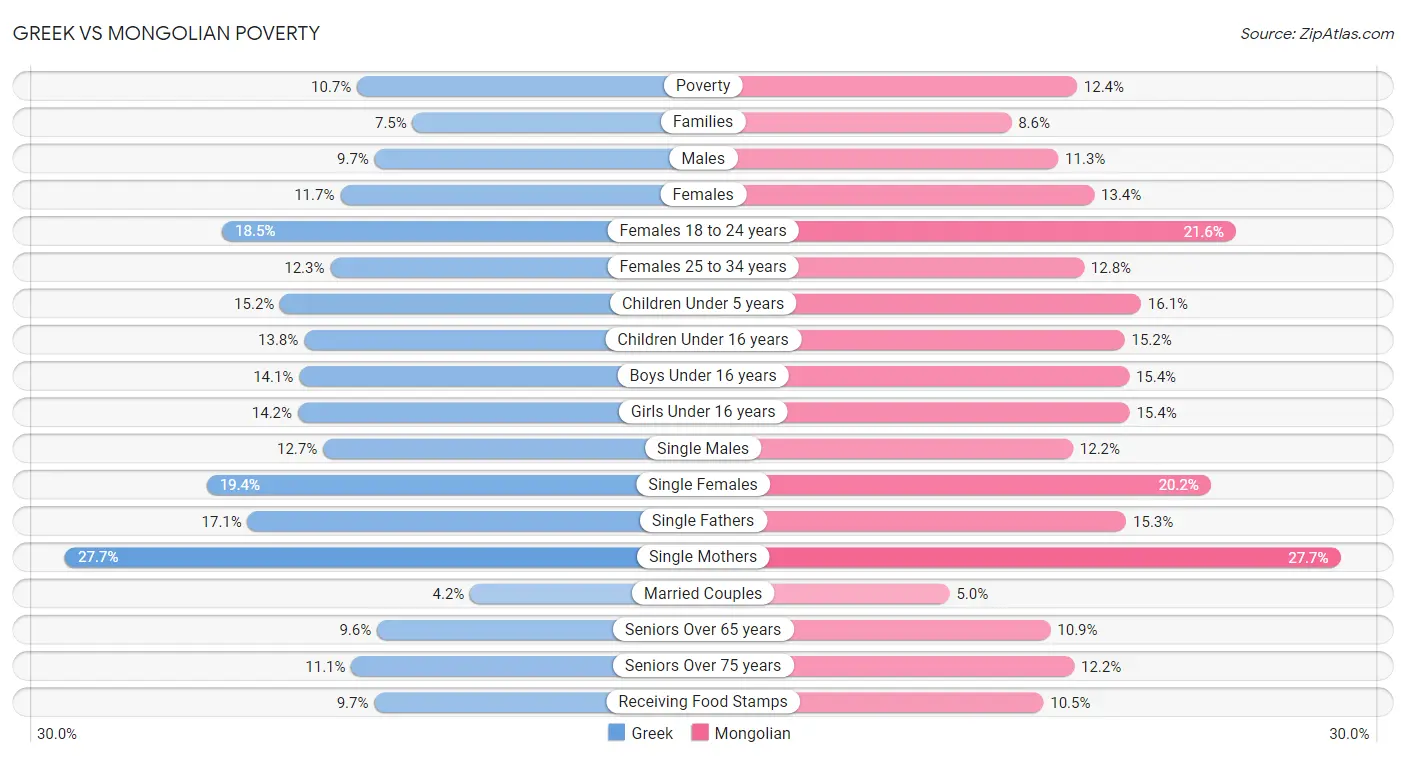
| Poverty Metric | Greek | Mongolian |
| Poverty | Exceptional 10.7% | Average 12.4% |
| Families | Exceptional 7.5% | Excellent 8.6% |
| Males | Exceptional 9.7% | Fair 11.3% |
| Females | Exceptional 11.7% | Average 13.4% |
| Females 18 to 24 years | Exceptional 18.5% | Tragic 21.6% |
| Females 25 to 34 years | Exceptional 12.3% | Exceptional 12.8% |
| Children Under 5 years | Exceptional 15.2% | Exceptional 16.1% |
| Children Under 16 years | Exceptional 13.8% | Excellent 15.2% |
| Boys Under 16 years | Exceptional 14.1% | Exceptional 15.4% |
| Girls Under 16 years | Exceptional 14.2% | Excellent 15.4% |
| Single Males | Good 12.7% | Exceptional 12.2% |
| Single Females | Exceptional 19.4% | Exceptional 20.2% |
| Single Fathers | Tragic 17.1% | Exceptional 15.3% |
| Single Mothers | Exceptional 27.7% | Exceptional 27.7% |
| Married Couples | Exceptional 4.2% | Good 5.0% |
| Seniors Over 65 years | Exceptional 9.6% | Average 10.9% |
| Seniors Over 75 years | Exceptional 11.1% | Average 12.2% |
| Receiving Food Stamps | Exceptional 9.7% | Exceptional 10.5% |
Greek vs Mongolian Unemployment
When considering unemployment, the most significant differences between Greek and Mongolian communities in the United States are seen in unemployment among women with children under 6 years (7.4% compared to 6.5%, a difference of 15.0%), unemployment among seniors over 75 years (9.4% compared to 8.6%, a difference of 9.5%), and unemployment among ages 25 to 29 years (6.6% compared to 6.2%, a difference of 7.4%). Conversely, both communities are more comparable in terms of unemployment among ages 65 to 74 years (5.4% compared to 5.3%, a difference of 0.38%), unemployment among women with children under 18 years (5.0% compared to 5.0%, a difference of 0.40%), and unemployment among ages 16 to 19 years (16.9% compared to 16.9%, a difference of 0.52%).
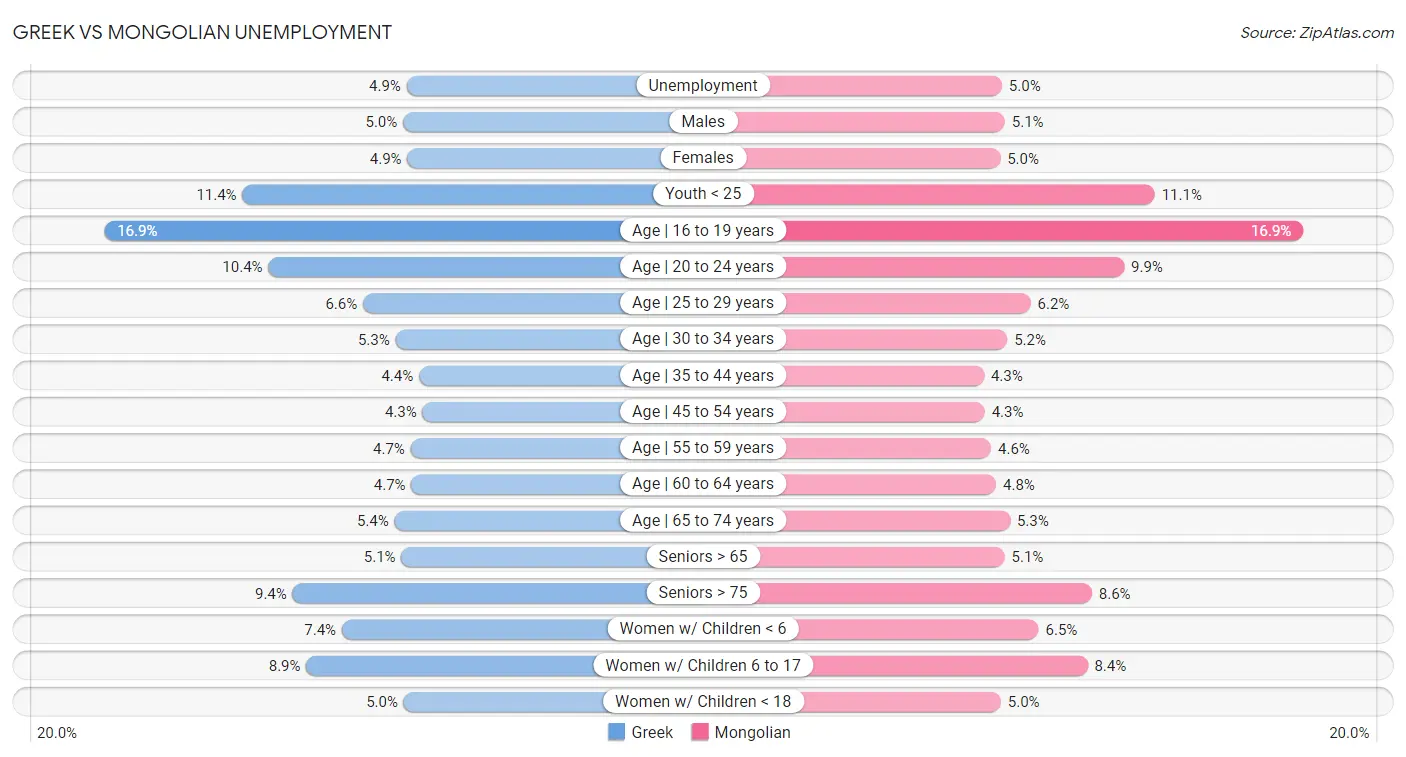
| Unemployment Metric | Greek | Mongolian |
| Unemployment | Exceptional 4.9% | Exceptional 5.0% |
| Males | Exceptional 5.0% | Excellent 5.1% |
| Females | Exceptional 4.9% | Exceptional 5.0% |
| Youth < 25 | Excellent 11.4% | Exceptional 11.1% |
| Age | 16 to 19 years | Exceptional 16.9% | Exceptional 16.9% |
| Age | 20 to 24 years | Fair 10.4% | Exceptional 9.9% |
| Age | 25 to 29 years | Average 6.6% | Exceptional 6.2% |
| Age | 30 to 34 years | Excellent 5.3% | Exceptional 5.2% |
| Age | 35 to 44 years | Exceptional 4.4% | Exceptional 4.3% |
| Age | 45 to 54 years | Exceptional 4.3% | Exceptional 4.3% |
| Age | 55 to 59 years | Excellent 4.7% | Exceptional 4.6% |
| Age | 60 to 64 years | Exceptional 4.7% | Excellent 4.8% |
| Age | 65 to 74 years | Average 5.4% | Good 5.3% |
| Seniors > 65 | Good 5.1% | Average 5.1% |
| Seniors > 75 | Tragic 9.4% | Excellent 8.6% |
| Women w/ Children < 6 | Excellent 7.4% | Exceptional 6.5% |
| Women w/ Children 6 to 17 | Good 8.9% | Exceptional 8.4% |
| Women w/ Children < 18 | Exceptional 5.0% | Exceptional 5.0% |
Greek vs Mongolian Labor Participation
When considering labor participation, the most significant differences between Greek and Mongolian communities in the United States are seen in in labor force | age 16-19 (38.9% compared to 35.3%, a difference of 10.2%), in labor force | age 20-24 (76.0% compared to 73.3%, a difference of 3.6%), and in labor force | age > 16 (64.9% compared to 66.1%, a difference of 1.7%). Conversely, both communities are more comparable in terms of in labor force | age 30-34 (85.3% compared to 85.3%, a difference of 0.010%), in labor force | age 35-44 (84.9% compared to 84.8%, a difference of 0.060%), and in labor force | age 45-54 (83.3% compared to 83.3%, a difference of 0.080%).

| Labor Participation Metric | Greek | Mongolian |
| In Labor Force | Age > 16 | Fair 64.9% | Exceptional 66.1% |
| In Labor Force | Age 20-64 | Exceptional 80.0% | Exceptional 79.9% |
| In Labor Force | Age 16-19 | Exceptional 38.9% | Tragic 35.3% |
| In Labor Force | Age 20-24 | Exceptional 76.0% | Tragic 73.3% |
| In Labor Force | Age 25-29 | Exceptional 85.5% | Exceptional 85.1% |
| In Labor Force | Age 30-34 | Exceptional 85.3% | Exceptional 85.3% |
| In Labor Force | Age 35-44 | Exceptional 84.9% | Exceptional 84.8% |
| In Labor Force | Age 45-54 | Exceptional 83.3% | Exceptional 83.3% |
Greek vs Mongolian Family Structure
When considering family structure, the most significant differences between Greek and Mongolian communities in the United States are seen in births to unmarried women (29.7% compared to 27.9%, a difference of 6.4%), divorced or separated (11.7% compared to 11.1%, a difference of 5.7%), and married-couple households (48.9% compared to 46.3%, a difference of 5.7%). Conversely, both communities are more comparable in terms of family households with children (27.1% compared to 27.6%, a difference of 1.6%), average family size (3.14 compared to 3.20, a difference of 1.8%), and single father households (2.1% compared to 2.1%, a difference of 1.9%).

| Family Structure Metric | Greek | Mongolian |
| Family Households | Excellent 64.7% | Tragic 62.8% |
| Family Households with Children | Poor 27.1% | Good 27.6% |
| Married-couple Households | Exceptional 48.9% | Average 46.3% |
| Average Family Size | Tragic 3.14 | Poor 3.20 |
| Single Father Households | Exceptional 2.1% | Exceptional 2.1% |
| Single Mother Households | Exceptional 5.6% | Exceptional 5.8% |
| Currently Married | Exceptional 48.8% | Fair 46.4% |
| Divorced or Separated | Exceptional 11.7% | Exceptional 11.1% |
| Births to Unmarried Women | Exceptional 29.7% | Exceptional 27.9% |
Greek vs Mongolian Vehicle Availability
When considering vehicle availability, the most significant differences between Greek and Mongolian communities in the United States are seen in no vehicles in household (9.5% compared to 13.1%, a difference of 38.2%), 4 or more vehicles in household (6.5% compared to 5.8%, a difference of 11.9%), and 3 or more vehicles in household (20.3% compared to 18.1%, a difference of 11.8%). Conversely, both communities are more comparable in terms of 1 or more vehicles in household (90.6% compared to 87.0%, a difference of 4.2%), 2 or more vehicles in household (57.5% compared to 52.8%, a difference of 8.8%), and 3 or more vehicles in household (20.3% compared to 18.1%, a difference of 11.8%).

| Vehicle Availability Metric | Greek | Mongolian |
| No Vehicles Available | Exceptional 9.5% | Tragic 13.1% |
| 1+ Vehicles Available | Exceptional 90.6% | Tragic 87.0% |
| 2+ Vehicles Available | Exceptional 57.5% | Tragic 52.8% |
| 3+ Vehicles Available | Excellent 20.3% | Tragic 18.1% |
| 4+ Vehicles Available | Good 6.5% | Tragic 5.8% |
Greek vs Mongolian Education Level
When considering education level, the most significant differences between Greek and Mongolian communities in the United States are seen in doctorate degree (2.1% compared to 2.8%, a difference of 29.3%), no schooling completed (1.6% compared to 2.1%, a difference of 29.0%), and professional degree (5.3% compared to 6.1%, a difference of 16.4%). Conversely, both communities are more comparable in terms of nursery school (98.4% compared to 97.9%, a difference of 0.52%), kindergarten (98.4% compared to 97.9%, a difference of 0.52%), and 1st grade (98.4% compared to 97.9%, a difference of 0.53%).
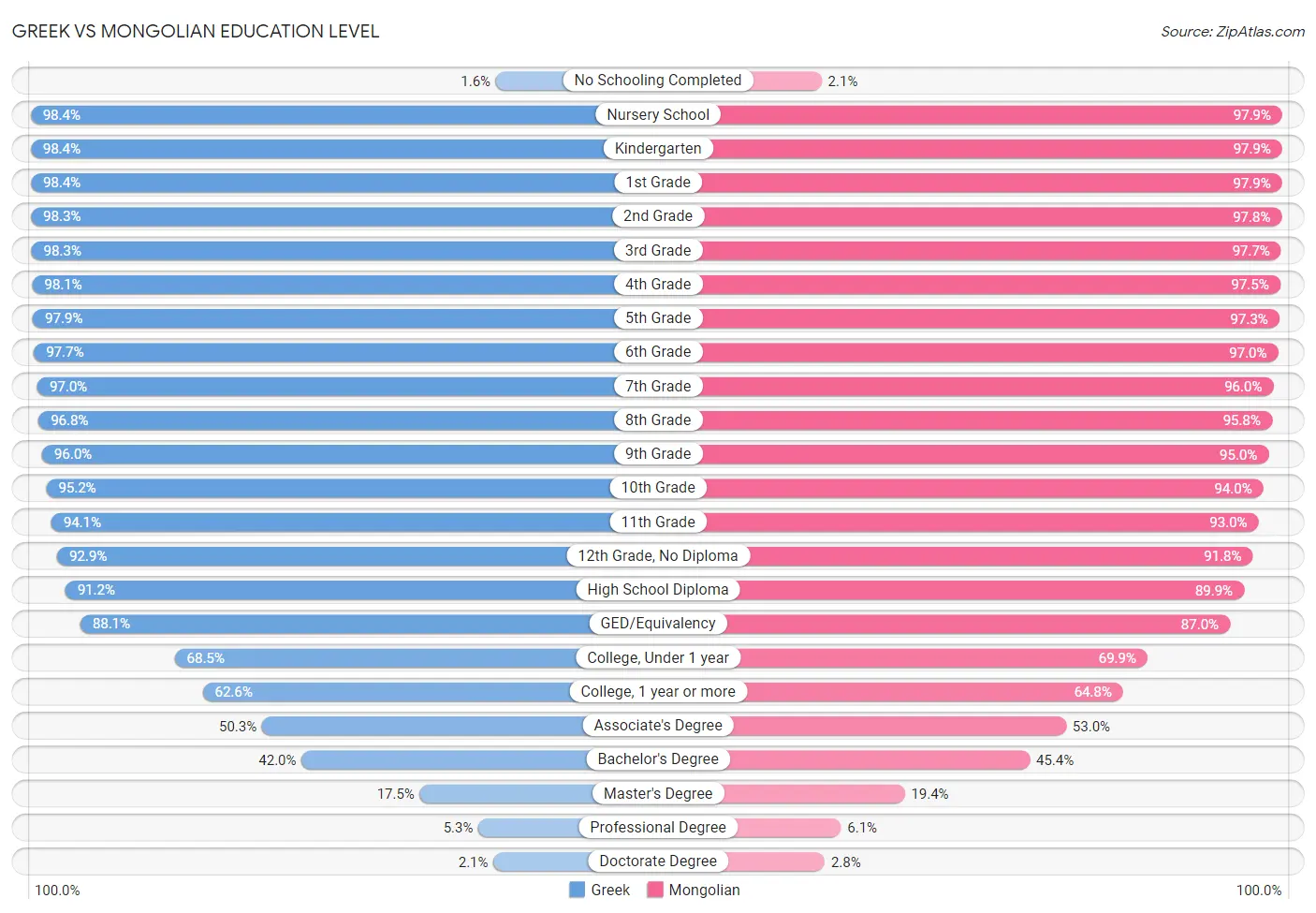
| Education Level Metric | Greek | Mongolian |
| No Schooling Completed | Exceptional 1.6% | Average 2.1% |
| Nursery School | Exceptional 98.4% | Fair 97.9% |
| Kindergarten | Exceptional 98.4% | Fair 97.9% |
| 1st Grade | Exceptional 98.4% | Fair 97.9% |
| 2nd Grade | Exceptional 98.3% | Fair 97.8% |
| 3rd Grade | Exceptional 98.3% | Fair 97.7% |
| 4th Grade | Exceptional 98.1% | Fair 97.5% |
| 5th Grade | Exceptional 97.9% | Fair 97.3% |
| 6th Grade | Exceptional 97.7% | Average 97.0% |
| 7th Grade | Exceptional 97.0% | Average 96.0% |
| 8th Grade | Exceptional 96.8% | Average 95.8% |
| 9th Grade | Exceptional 96.0% | Good 95.0% |
| 10th Grade | Exceptional 95.2% | Good 94.0% |
| 11th Grade | Exceptional 94.1% | Excellent 93.0% |
| 12th Grade, No Diploma | Exceptional 92.9% | Excellent 91.8% |
| High School Diploma | Exceptional 91.2% | Exceptional 89.9% |
| GED/Equivalency | Exceptional 88.1% | Exceptional 87.0% |
| College, Under 1 year | Exceptional 68.5% | Exceptional 69.9% |
| College, 1 year or more | Exceptional 62.6% | Exceptional 64.8% |
| Associate's Degree | Exceptional 50.3% | Exceptional 53.0% |
| Bachelor's Degree | Exceptional 42.0% | Exceptional 45.4% |
| Master's Degree | Exceptional 17.5% | Exceptional 19.4% |
| Professional Degree | Exceptional 5.3% | Exceptional 6.1% |
| Doctorate Degree | Exceptional 2.1% | Exceptional 2.8% |
Greek vs Mongolian Disability
When considering disability, the most significant differences between Greek and Mongolian communities in the United States are seen in disability age under 5 (1.5% compared to 1.1%, a difference of 27.8%), hearing disability (3.2% compared to 2.7%, a difference of 18.1%), and male disability (11.4% compared to 10.3%, a difference of 10.8%). Conversely, both communities are more comparable in terms of disability age 65 to 74 (21.8% compared to 21.8%, a difference of 0.010%), disability age over 75 (45.6% compared to 46.3%, a difference of 1.5%), and self-care disability (2.4% compared to 2.3%, a difference of 2.9%).
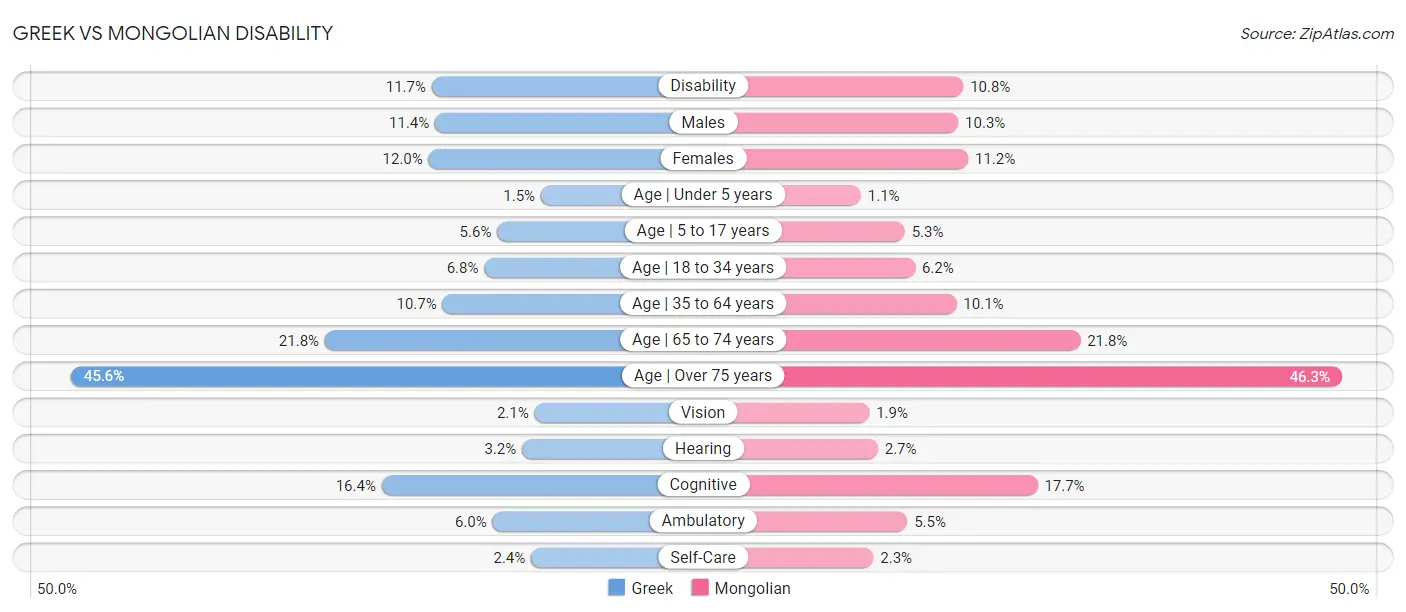
| Disability Metric | Greek | Mongolian |
| Disability | Average 11.7% | Exceptional 10.8% |
| Males | Fair 11.4% | Exceptional 10.3% |
| Females | Excellent 12.0% | Exceptional 11.2% |
| Age | Under 5 years | Tragic 1.5% | Exceptional 1.1% |
| Age | 5 to 17 years | Good 5.6% | Exceptional 5.3% |
| Age | 18 to 34 years | Poor 6.8% | Exceptional 6.2% |
| Age | 35 to 64 years | Exceptional 10.7% | Exceptional 10.1% |
| Age | 65 to 74 years | Exceptional 21.8% | Exceptional 21.8% |
| Age | Over 75 years | Exceptional 45.6% | Exceptional 46.3% |
| Vision | Exceptional 2.1% | Exceptional 1.9% |
| Hearing | Tragic 3.2% | Exceptional 2.7% |
| Cognitive | Exceptional 16.4% | Tragic 17.7% |
| Ambulatory | Good 6.0% | Exceptional 5.5% |
| Self-Care | Exceptional 2.4% | Exceptional 2.3% |